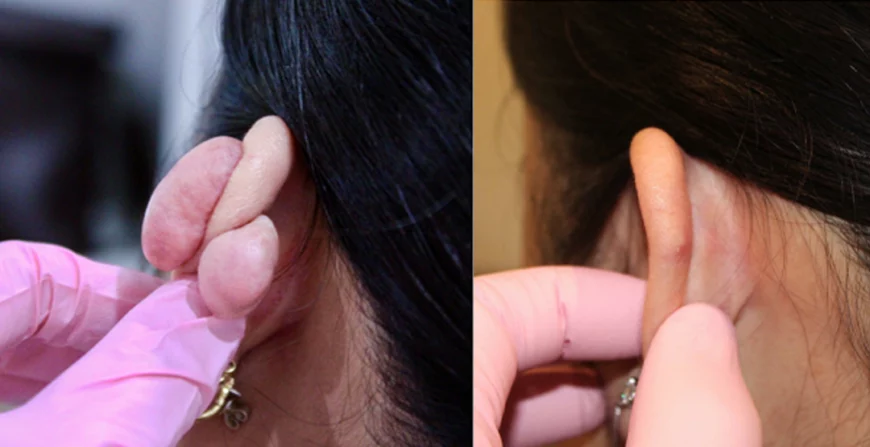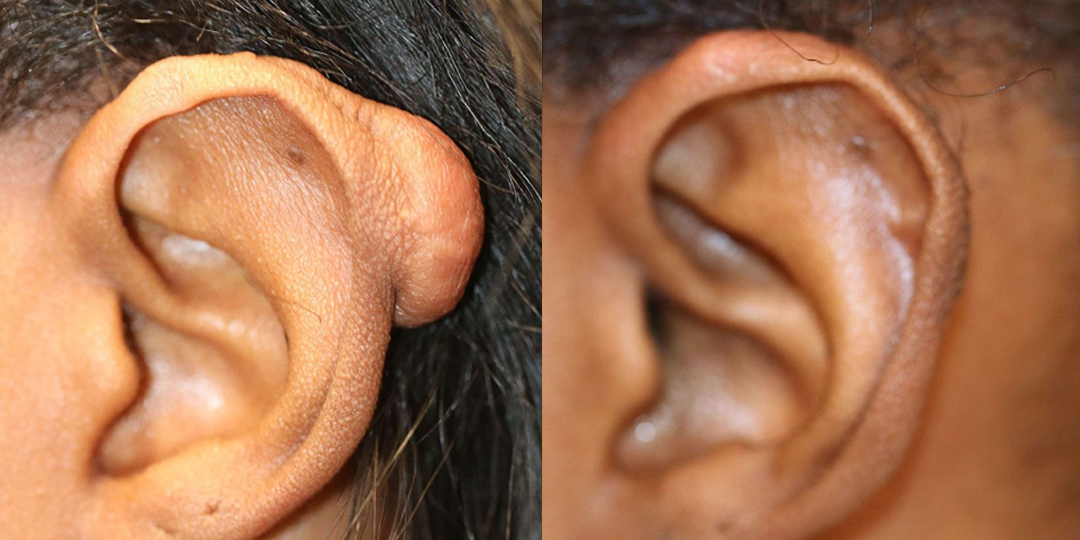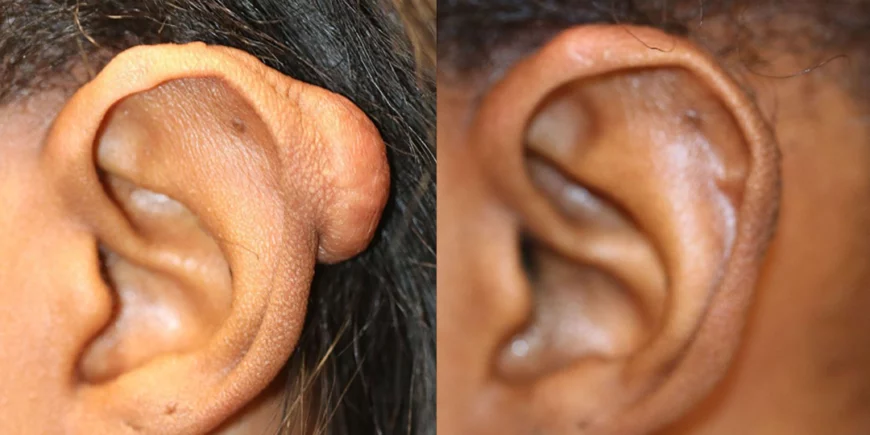Keloid scars are one of the most common scars dermatologists treat. We use a combination of topicals, anti-inflammatory injections & lasers to reduce the size & symptoms of keloid scarring.
Key Points
- Keloid & hypertrophic scars commonly occur on the shoulder, chest, back
- They are often secondary to acne, surgical excisions but may occur spontaneously
- Dermatologists employ a series of injections, pulse dye & fractional lasers to effectively treat keloids
- Most treatments are partially covered under Medicare
Keloid Scar Treatments at a glance
Our results speak for themselves

Before
After

Keloid excision, modified graft & compression post operatively
Ask us more about this treatmant
Preferred Consultation

Before
After

Keloid excision & compression post operatively
Ask us more about this treatmant
Preferred Consultation

Before
After

Keloid excision & compression post operatively
Ask us more about this treatmant
Preferred Consultation
FAQs
What are keloid scars & why are they challenging to treat?
Keloid scars are raised scars that are frequently seen in Ethnics. They usually occur after trauma (acne, burns,) or surgery (excision, piercings). Most keloids have colour changes on the surface- either red or darker skin.
Treatment can be challenging, as most often there are multiple scars at different stages of development. Dermatologists are experts in treating all forms of scarring, including keloid & hypertrophic scars.
When should you get keloid scars treated?
Keloids should be treated if-
- They cause symptoms such as itch or pain
- They are unsightly and are visible to others
The keloid is growing
How can dermatologists treat keloid scars?
Your Dermatologist will examine the affected areas & come up with a treatment plan. Here are some of the treatment options that we provide at the Cutis Clinic:
- Topical treatments – Anti-inflammatory ointments, silicone gel or tape
- Cryotherapy – Nitrogen can be used to freeze off or soften a keloid scar.
- Steroid Injections – This is a very effective and commonly used treatment for both hypertrophic & keloid scars. This can also work well through a course of regular injections over several weeks.
- Lasers – Lasers are a great way to reduce the appearance of keloid scars.
Surgery – For larger scars, surgery to remove the keloid and excess skin can be a very effective treatment. In most cases we follow this up with superficial fractional radiotherapy.
How are our injections different compared to other doctors?
Dermatologists are trained to approach scars differently. We use different concentrations & techniques. As a guide-
- Corticosteroid injections are usually higher strength
- The level of placement is more superficial
- We combine 5 Fluorouracil with steroids
- We can pre-treat with cryotherapy or pulse dye laser
- We combine fractional laser with topical CS preps
- We use anti-wrinkle to reduce scar contraction
How many injection sessions will I need?
It is very rare that we flatten a keloid or hypertrophic scar in one session. Often 2-6 sessions are required. In some cases, up to 20.
Injections are spaced 6-8 weeks apart to prevent skin atrophy or thinning. Be guided by your dermatologist.
Can lasers treat keloids & hypertrophic scars?
Pulse dye laser is great for flat red scars. This laser reduces the blood vessels within scars. Fractional CO2 lasers are best for treating raised keloids that are resistant to injections.
Patients will require a series of treatments, ranging from 2-8. These are spaced 6-8 weeks apart.
Products

O Cosmedics cleansing range
$63.00-$64.00

O Biotics 3D Hyaluronic Serum
From $97.00
Our specialists manage keloids using the very latest injection techniques, coupled with technologically advanced lasers. We are also experienced in managing more complex keloids including ear keloids & post surgical keloids.
What causes keloid scarring?
Keloid scars occur when there is an overproduction of collagen in the skin. They are more common in younger patients, as well as ethnic skin types. Asians, Africans, Islanders are more prone to keloid scars. Other factors that come into play include-
- Gender- more common in females than males
- Location- upper chest, shoulders, back, ears, chin & neck
- Trauma- burns, vaccinations, acne or surgery
Whatever the cause, our team of dermatologists have many years of experience treating this type of scar and can help you. They offer many different modalities of treatment and advise you accordingly.
How do we treat ear keloids?
Ear keloids are seen more frequently in young patients, the most common cause is ear piercings. They can occur at the front, back, or both sides of the ear. They are more common on the top cartilage part of the ear.
We excise the keloid & find the base, taking care to remove it completely. Ear keloids are
special- they require compression for 3-6 months post-surgery. Compression reduces recurrence by up to 85%.
Can you treat keloids at home?
Rarely, home treatments work. If you are motivated-
- Buy some silicone tape or sheets. Use daily for 3-9 months.
- Compression for ear keloids can reduce extension.
- Silicone gel can be useful for early keloids.
Strong steroid creams can be marginally effective
Why can’t you just cut out a keloid?
We can, but chances are it will grow back- often bigger. Resistant keloids can be excised; however the chances of recurrence are high. On this basis, it is advisable to follow up treatment with radiotherapy.
Radiotherapy is carried out over 3-8 sessions, or fractional treatments. With this technique, recurrence is reduced by over 85%
Why is a keloid prevention strategy important?
It is far easier to prevent keloids than to treat them. If you are prone to scarring, plan to see a dermatologist prior to surgery. One of the biggest preventable scars are caesarean section scars.
Inform your surgeon that you are prone to keloids. There are modified ways of suturing to reduce the chances of scarring.
Can I have a tattoo if I am prone to keloid scarring?
Yes, however you will need to discuss this with your tattoo artists. Tattoo keloids are more common on the chest, shoulders & back. In some cases, a test spot can determine if you are prone to scarring. Heavy lines (deeper ink) have a higher chance of scarring compared to lighter shading.
Dermatologists can also help you with mitigating scarring post ink with topical anti-inflammatories & silicone tape.


